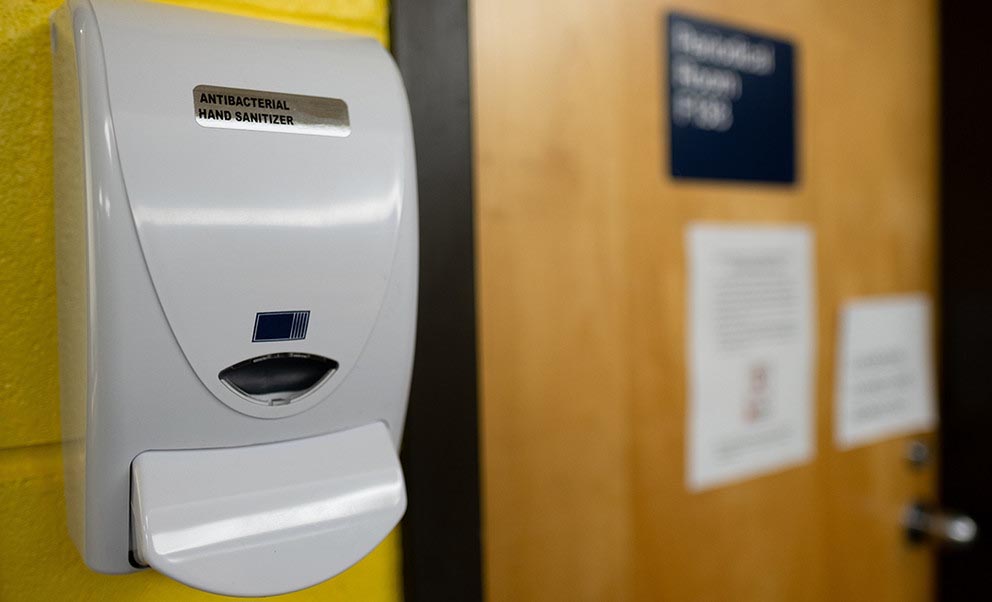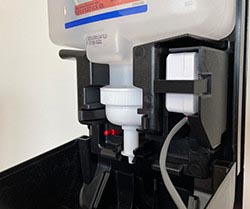
In an effort to optimize Penn State's hand sanitizer management and maintenance operations, a team of engineering researchers designed, developed and installed a wireless sensor system on the hand sanitizer stations found in Hammond Building. IMAGE: ADOBE STOCK
Wireless sensors track sanitizer use, optimize replacement and refill operations
3/25/2021
By Samantha Chavanic
UNIVERSITY PARK, Pa. — To help slow the spread of the coronavirus, Penn State deployed nearly 6,000 hand sanitizer stations across its campuses for the fall 2020 semester, with almost 3,000 stations installed at the University Park campus. But with no way to track station usage or hand sanitizer levels, the University’s Office of Physical Plant (OPP) needs to physically visit each station to check which need replacement or refill.
An interdisciplinary team of Penn State College of Engineering and College of Agricultural Sciences researchers worked to optimize OPP’s Building and Grounds’ sanitizer management and maintenance operation by designing and developing a wireless sensor system.
Project lead Sven Bilén, professor of engineering design, electrical engineering and aerospace engineering, explained that, to the uninitiated, the initial ask seemed simple — add wireless sensors to the hand sanitizer dispensers to notify OPP’s Custodial Operations team when the stations were empty.
Bilén recognized that a solution would be more complex than the simple ask. So, he assembled a team of engineering faculty, staff and students that took a systems design approach. They began by researching how to address four smaller problems: how to know when dispenser levers are pushed, when a sanitizer bottle is replaced, how to send that data to the cloud and what to do with that data, and how to report it back to stakeholders.
The project began with Bilén and Joe Portelli, senior design specialist at Penn State’s Integrated Design Solutions, working with OPP to understand existing LoRaWAN networks at Penn State. LoRaWAN, a simple open-source network, offers low-cost, long-range, bi-directional communication between sensors and servers. Bilén and Portelli also partnered with Custodial Operations to learn how personnel service the sanitizer dispensers and the types of information that would be most useful to them. Armed with this information, the team chose to implement a demonstration wireless sensor system in the Hammond Building at the University Park campus.
According to Bilén, the team selected the Hammond Building for four reasons — ease of working with the College of Engineering’s IT and networking professionals, wireless propagation challenges due to the building’s construction, the building’s size and the large number of sanitizers located in the building.
“Hammond demonstrates a worst-case scenario for our network,” he said. “It’s a large building that would show how far away the sensors could connect. It has a large number of sanitizer dispensers installed, so that would allow us to test many sensors being connected to the network. And it has a challenging wireless signal environment due to many metal walls.”
Team member Jared Butler, assistant professor of engineering design, developed a mechanical system to identify when sanitizer bottles are replaced. Using compliant mechanisms — devices that bend to move — custodial services personnel can install and operate the system without additional training. Butler’s 3D-printed mechanism design triggers a sensor switch only when a sanitizer bottle is removed and replaced.
Butler explained that, though the team never met in-person to design and develop the system due to the pandemic, high levels of coordination and collaboration enabled the project’s success.
“I am able to design and prototype the device at home with access to computer-aided design software and a 3D printer,” he said. “Other team members sent me their mechanical parts through electronic or physical mail. I can print their components, ensure they are compatible with mine and test them in a sanitizer pump that was sent to me and now is conveniently located in my bedroom closet. It is really quite beautiful how we can share ideas and collaborate on such a physical project while never seeing one another in person.”
Randall Bock, assistant research professor of agricultural and biological engineering, designed and 3D-printed holders for the sensors, allowing them to snap into existing sanitizer dispensers.
Junqi Zhao, architectural engineering doctoral alumnus, and Boyang Zhou, a computer science junior in the Schreyer Honors College, designed and developed an IoT system to capture, store and manage the collected data. They researched wireless network solutions for data communication and created a cloud-based management-and-analysis platform for the Hammond Building sanitizer stations.
“Applying IoT [Internet of Things] techniques for facility management is a trending area in which a lot of interesting research topics can be explored,” Zhao said. “Implementing the project on a Penn State campus gives us the opportunity to further investigate broad research questions in a real-world scenario.”
Bilén highlighted the importance of creating real-world scenarios for students and applying the “living lab” concept to the University Park campus.
“We are able to engage students in their educational journey to develop something with real impact,” he said. “We are able to use our facilities in non-interference manners, which when successful will provide real value.”
Butler explained the team’s next step as iteration.
“We really embraced the idea of iteration and trust it will help us make change,” he said. “Now that sensors have been deployed, we test, observe, evaluate and implement lessons learned. This is what will allow us to broaden the impact of this project beyond the walls of Hammond Building.”
Funds for the project were provided by the School of Engineering Design, Technology, and Professional Programs and the Manufacturing and Sterilization for COVID-19 initiative.





